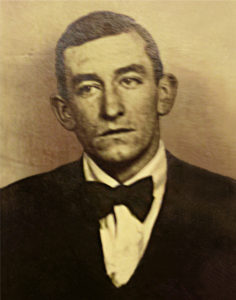I’ve always been intrigued by the legend or story that one of my ancestors was killed fighting for Irish independence. In fact, in one of my earlier posts Mary C. O’Rourke Stupfel says on videotape that two of her cousins and childhood playmates in Ireland, the Quinn boys, were later involved in the Irish insurrection. One of the boys was killed, according to the story. The other was injured and later recovered.

By UnknownDigital Photography: Conor DevlinDerivative work: MagentaGreen – This file was derived from Padraig Quinn(19241112).jpg:, Public Domain, https://commons.wikimedia.org/w/index.php?curid=48149627
This was the second time I’ve heard this story in my family. In my earlier post on the video, Mary C. says the cousins’ names were John and Patrick Quinn. Each time I watched the video, I wanted to learn more about this story and find out just who the Quinn boys were and what their involvement was in the quest for Irish independence.
When I initially heard the story, I assumed she was talking about the Easter Rising in 1916. The Easter Rising was an armed insurrection in Ireland during Easter Week, April 1916 and it occurred in Dublin. Irish republicans launched the conflict to end British rule in Ireland and establish an independent Irish Republic while the United Kingdom was heavily engaged in the First World War. It lasted for six days and the British eventually suppressed the insurrection. Some 485 people were killed including IRA members, British military and civilians.1
The event was significant because soon after, the British executed 15 lRA leaders, in essence turning public opinion against the British and paving the way toward Irish independence.2
John Quinn was not killed in the Easter Rising, nor was he killed in the Irish War for Independence that occurred between 1919 and 1921. John Quinn, later known as Sean Quinn, was killed in the lesser known Irish Civil War in 1923. His brother Patrick, known as Padraig, was captured in the same conflict, but survived and was later released.
The Irish Civil War
The Civil War broke out between opposing factions of the IRA after the treaty with Britain was signed establishing the Irish Free State. The treaty was rather contentious, but the majority of the IRA, including Michael Collins, supported it. The other faction, anti-treaty IRA members, believed the treaty with Britain didn’t go far enough toward Irish independence.3
Sean Quinn was a high ranking officer in the Fourth Northern Division of the Irish Republican Army and staunchly anti-treaty. He was ultimately killed by his own countrymen, Irish Free State troops.
According to the sources, Sean was at safe house in Castlebellingham in County Louth on April 23, 1923 with his brothers Padraig and Malachi, and other anti-treaty IRA leaders. A Catholic priest who said Sunday Mass betrayed them and soon a large force of Free State troops surrounded their safe house when Sean decided they had to shoot their way out. Both Sean and Padraig were shot and captured. The others escaped. A week later, the civil war ended. Sean died from his injuries a month later on May 22, 1923 in St. Brecin’s Hospital in Dublin.4
The Milestone
Interestingly, Sean’s father, John Quinn, was the proprietor of The Milestone, the first supermarket in Newry, County Down established in 1909. My great grand aunt Catherine Rogers Murphy, listed the elder Quinn as her closest Irish relative when she immigrated to the United States in 1910. Mr. Quinn subsequently opened other supermarkets in Ireland and ended up doing quite well for himself before he passed away in 1955.5
Padraig later became a general practitioner in Ireland after living in the US and England.6
Sean and Padraig’s nephew is Rauri Quinn, former leader of the Irish Labour Party and Irish Finance Minister and currently the Chairperson of the Institute of International and European Affairs, Ireland’s leading think tank on European and International affairs.
Sean ultimately died for a cause he believed in – total Irish independence from Britain with no strings attached.
- “Easter Rising.” Wikipedia. Wikimedia Foundation, 24 May 2017. Web. 24 May 2017. <https://en.wikipedia.org/wiki/Easter_Rising>.
- “Easter Rising.” Wikipedia. Wikimedia Foundation, 24 May 2017. Web. 24 May 2017. <https://en.wikipedia.org/wiki/Easter_Rising>.
- Dorney, John. “Today in Irish History, August 14, 1922, The Anti-Treaty IRA Attack on Dundalk.” The Irish Story. N.p., 15 Aug. 2015. Web. 24 May 2017. <http://www.theirishstory.com/2013/08/14/today-in-irish-history-august-14-1922-the-anti-treaty-ira-attack-on-dundalk/#.WSZJqesrIkK>.
- Gutenberg, Project. “Sean F. Quinn.” Sean F. Quinn | Project Gutenberg Self-Publishing – EBooks | Read EBooks Online. N.p., n.d. Web. 24 May 2017. <http://www.gutenberg.us/articles/sean_f._quinn>.
- Boyle, Fabian. “Many Personalities Lived And Worked On Main Street.” Newry Memoirs – Many Personalities Lived And Worked On Main Street 2. N.p., n.d. Web. 24 May 2017. <http://www.newrymemoirs.com/stories_pages/hillstpersonalities_2.html>.
- “Pádraig Ó Cuinn.” Wikipedia. Wikimedia Foundation, 29 Jan. 2017. Web. 24 May 2017. <https://en.wikipedia.org/wiki/P%C3%A1draig_%C3%93_Cuinn>.

My great grandmother was Catherine Rogers Murphy
I think we’ve spoken before.